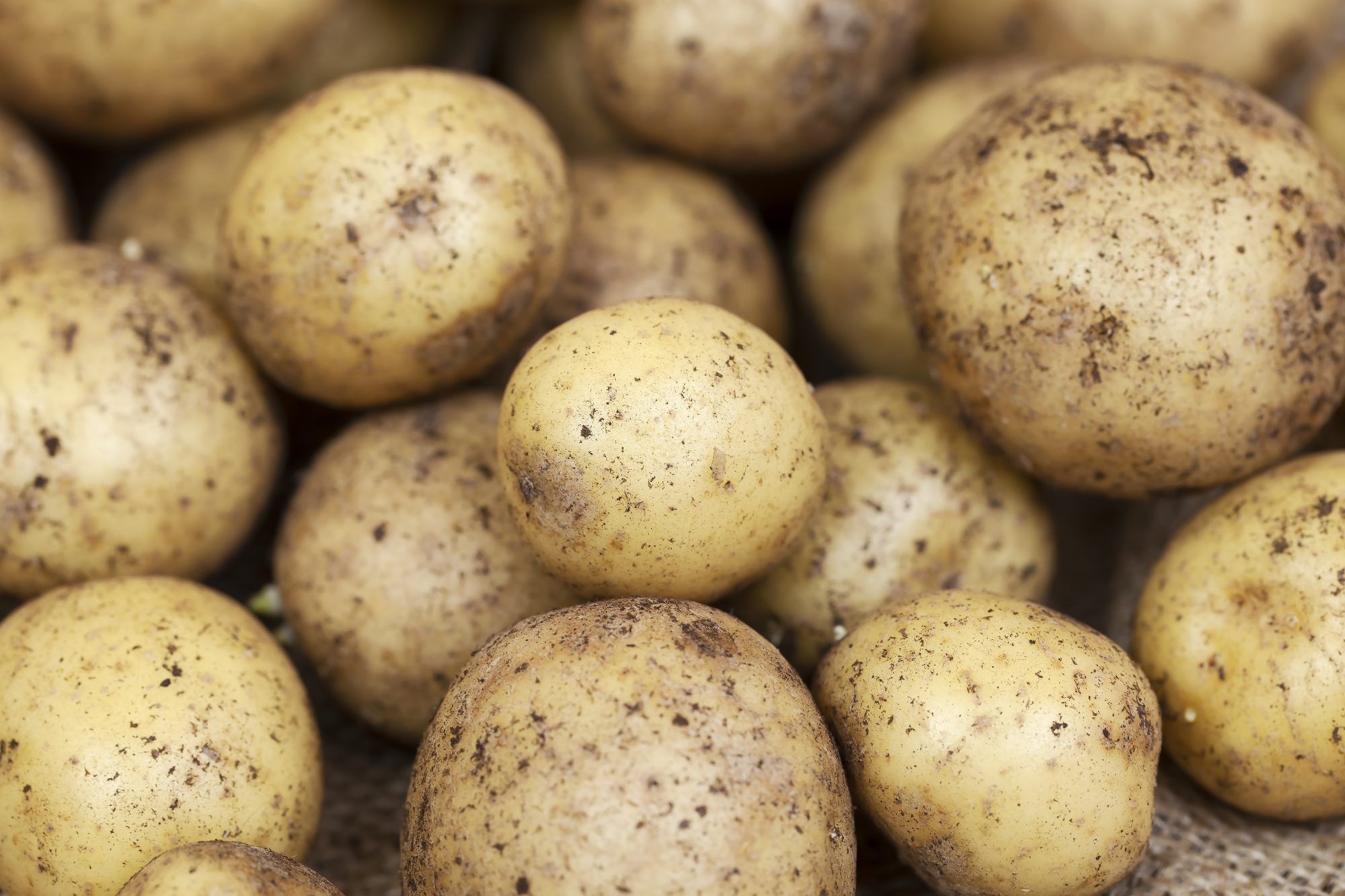Potato is a / आलू है
(1) Root / जड़
(2) Stem / तना
(3) Bud / कली
(4) Fruit / फल
(SSC CGL Tier-I (CBE) Exam.31.08.2016)
Answer / उत्तर :-
(2) Stem / तना

Explanation / व्याख्या :-
आलू कंदों के उदाहरण हैं: स्टोलन के सूजे हुए सिरे जिनमें स्टार्च जमा हो सकता है। यह एक तना है क्योंकि इसमें कई नोड्स होते हैं जिन्हें आंखें कहा जाता है और आंखों के बीच रिक्त स्थान होते हैं जिन्हें इंटर्नोड्स के रूप में जाना जाता है। आलू के कंद सूजे हुए भूमिगत तना संरचनाओं, प्रकंदों के अंत में विकसित होते हैं। आलू की आंखें वास्तव में अक्षीय कलिकाएं होती हैं जिनमें प्रत्येक स्थान पर कई छोटी कलियां होती हैं। इन कलियों का विस्तार करके अंकुर बन सकते हैं जो बढ़ते हुए पूरे पौधे बनाते हैं।
आलू सोलनम ट्यूबरोसम पौधे का एक स्टार्चयुक्त कंद है और अमेरिका की मूल सब्जी है। यह पौधा नाइटशेड परिवार सोलानेसी में एक बारहमासी है।
जंगली आलू की प्रजातियाँ कनाडा से लेकर दक्षिणी चिली तक पूरे अमेरिका में पाई जा सकती हैं। मूल रूप से माना जाता था कि आलू को मूल अमेरिकियों द्वारा स्वतंत्र रूप से कई स्थानों पर पालतू बनाया गया था, लेकिन बाद में आनुवंशिक अध्ययनों ने वर्तमान दक्षिणी पेरू और चरम उत्तर-पश्चिमी बोलीविया के क्षेत्र में एक ही मूल का पता लगाया। सोलनम ब्रेविकॉल कॉम्प्लेक्स की एक प्रजाति से लगभग 7,000-10,000 साल पहले आलू को वहां पालतू बनाया गया था। दक्षिण अमेरिका के एंडीज क्षेत्र में, जहां प्रजाति स्वदेशी है, आलू के कुछ करीबी रिश्तेदारों की खेती की जाती है।
16वीं शताब्दी के उत्तरार्ध में स्पेनियों द्वारा आलू को अमेरिका से यूरोप लाया गया था। आज वे दुनिया के कई हिस्सों में मुख्य भोजन हैं और दुनिया की अधिकांश खाद्य आपूर्ति का एक अभिन्न अंग हैं। 2014 तक, मक्का (मकई), गेहूं और चावल के बाद आलू दुनिया की चौथी सबसे बड़ी खाद्य फसल थी। चयनात्मक प्रजनन के सहस्राब्दियों के बाद, अब 5,000 से अधिक विभिन्न प्रकार के आलू हैं। वर्तमान में दुनिया भर में खेती की जाने वाली 99% से अधिक आलू दक्षिण-मध्य चिली के निचले इलाकों में पैदा हुई किस्मों से आती हैं। खाद्य स्रोत और पाक सामग्री के रूप में आलू का महत्व क्षेत्र के अनुसार भिन्न होता है और अभी भी बदल रहा है। यह यूरोप, विशेष रूप से उत्तरी और पूर्वी यूरोप में एक आवश्यक फसल बनी हुई है, जहां प्रति व्यक्ति उत्पादन अभी भी दुनिया में सबसे ज्यादा है, जबकि पिछले कुछ दशकों में उत्पादन में सबसे तेजी से विस्तार दक्षिणी और पूर्वी एशिया में हुआ है, चीन और भारत के साथ 2018 तक समग्र उत्पादन में दुनिया का नेतृत्व किया।
टमाटर की तरह, आलू जीनस सोलनम में एक नाइटशेड है, और आलू के वानस्पतिक और फलने वाले हिस्सों में टॉक्सिन सोलनिन होता है जो मानव उपभोग के लिए खतरनाक है। सामान्य आलू के कंद जो ठीक से उगाए गए और संग्रहीत किए गए हैं, वे मानव स्वास्थ्य के लिए नगण्य होने के लिए पर्याप्त मात्रा में ग्लाइकोकलॉइड का उत्पादन करते हैं, लेकिन, अगर पौधे के हरे भाग (अर्थात् अंकुरित और खाल) प्रकाश के संपर्क में आते हैं, तो कंद पर्याप्त उच्च सांद्रता जमा कर सकता है ग्लाइकोकलॉइड मानव स्वास्थ्य को प्रभावित करते हैं।
Potatoes are examples of tubers : the swollen ends of stolons that may store starch. It is a stem because it has many nodes called eyes with spaces between eyes known as internodes. Potato tubers develop at the end of swollen underground stem structures, rhizomes. Eyes of potatoes are really axillary buds which contain several small buds at each site. These buds can expand to form shoots which grow on to make whole plants.
The potato is a starchy tuber of the plant Solanum tuberosum and is a root vegetable native to the Americas. The plant is a perennial in the nightshade family Solanaceae.
Wild potato species can be found throughout the Americas, from Canada to southern Chile. The potato was originally believed to have been domesticated by Native Americans independently in multiple locations, but later genetic studies traced a single origin, in the area of present-day southern Peru and extreme northwestern Bolivia. Potatoes were domesticated there approximately 7,000–10,000 years ago, from a species in the Solanum brevicaule complex. In the Andes region of South America, where the species is indigenous, some close relatives of the potato are cultivated.
Potatoes were introduced to Europe from the Americas in the second half of the 16th century by the Spanish. Today they are a staple food in many parts of the world and an integral part of much of the world’s food supply. As of 2014, potatoes were the world’s fourth-largest food crop after maize (corn), wheat, and rice.Following millennia of selective breeding, there are now over 5,000 different types of potatoes. Over 99% of potatoes presently cultivated worldwide descended from varieties that originated in the lowlands of south-central Chile.The importance of the potato as a food source and culinary ingredient varies by region and is still changing. It remains an essential crop in Europe, especially Northern and Eastern Europe, where per capita production is still the highest in the world, while the most rapid expansion in production over the past few decades has occurred in southern and eastern Asia, with China and India leading the world in overall production as of 2018.
Like the tomato, the potato is a nightshade in the genus Solanum, and the vegetative and fruiting parts of the potato contain the toxin solanine which is dangerous for human consumption. Normal potato tubers that have been grown and stored properly produce glycoalkaloids in amounts small enough to be negligible to human health, but, if green sections of the plant (namely sprouts and skins) are exposed to light, the tuber can accumulate a high enough concentration of glycoalkaloids to affect human health.














No comments:
Post a Comment